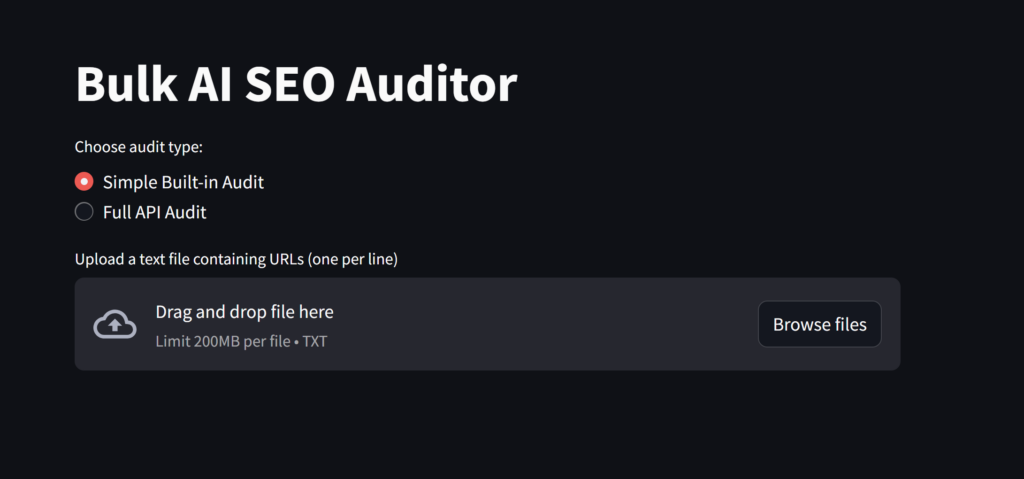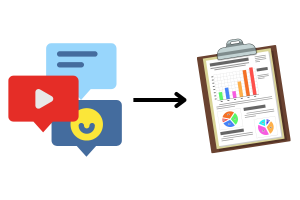Free AI-Powered SEO Audit Tool: Automate Your On-Page SEO Like a Pro

Are you tired of spending hours manually auditing your website’s SEO?
What if I told you there’s a free, AI-powered tool I developed for you that can change your on-page SEO process and make it 10X faster and more powerful?

In this post, I will show you a game-changing solution that will save you time, improve your search rankings, and even make you money!
The Core Idea: Automating On-Page SEO Audits with AI
In this post, I will show you how to automate on-page SEO audits using AI.
I’ve developed a free tool that not only simplifies the SEO audit process but also provides actionable insights to boost your website’s performance.
Here’s what you can expect:
- An introduction to our free AI-powered SEO audit tool
- Step-by-step instructions on how to set up and use the tool
- The complete source code, allows you to customize and build upon the tool
- Insider tips on how to monetize this technology
But before we jump in, let’s clarify what on-page SEO audits are all about.
Understanding On-Page SEO Audits
On-page SEO audits are like giving your website a health check-up.
They help you identify areas where your website can improve its visibility to search engines.
Think of search engines as picky readers – they have specific things they look for to determine if your content is worth recommending to others.
Typically, an on-page SEO audit includes:
- Analyzing page titles and meta descriptions (like the cover and blurb of a book)
- Checking header tags (H1, H2, etc. – think of these as chapter titles)
- Evaluating content quality and keyword usage (the meat of your content)
- Assessing internal and external links (connections to other relevant information)
- Reviewing image optimization (making sure pictures load quickly and have descriptive names)
- Checking page load speed and mobile-friendliness (because no one likes a slow, clunky website)
While many premium tools are available for SEO audits, they can be expensive and sometimes overwhelming for beginners.
That’s why I decided to create a free, user-friendly alternative that leverages the power of AI to provide valuable insights.
Introducing the AI-powered SEO Audit Tool
Our free tool simplifies the SEO audit process by automating the analysis and providing AI-generated optimization suggestions.
Here’s how it works:
- You provide a list of URLs you want to analyze and optimize.
- The tool loops through each URL and generates an SEO report.
- The report is then passed to an AI model (like OpenAI’s Models or Anthropic’s Claude) for analysis.
- The AI provides optimization tips and suggestions to improve each page.
The AI analyzes the SEO report by comparing it to best practices and patterns it has learned from millions of web pages.
It looks for common issues like missing meta descriptions, poorly optimized titles, or content that doesn’t align well with the target keywords.
Then, it generates suggestions in plain English, almost like having a friendly SEO expert looking over your shoulder.
For example, the AI might suggest:
- “Your title tag is currently 80 characters long. Consider shortening it to 60 characters to ensure it displays fully in search results.”
- “The H1 tag ‘Welcome to our site’ is generic. Try including your main keyword, like ‘Expert Plumbing Services in Seattle’.”
- “Your content mentions ‘pipe repair’ several times, but not ‘plumbing services’. Consider adding this key phrase to improve relevance.”
Setting Up and Running the SEO Audit Tool
Follow these steps to get the tool up and running:
First, Download the project files:
Prepare Your Environment:
- Ensure you have Python installed on your computer. If not, download and install Python.
- Open the project your preferred Integrated Development Environment (IDE). We’ll use Visual Studio Code in this example.
Set Up Your Project:
- Open your terminal or command prompt.
- Create a virtual environment.
. - Activate the virtual environment:
- For Windows:
venv\Scripts\activate - For macOS and Linux:
source venv/bin/activate
- For Windows:
- Install required libraries:
pip install simplerllm streamlit
Set Up API Keys:
- Create a file named
.envin your project directory. - Add your OpenAI API key:
OPENAI_API_KEY = "sk-proj-XXX"(replace “XXX” with your actual key)
Run the Tool:
- Use the command:
streamlit run app.py - This will open the tool in your default web browser.

Using the Tool:
- Prepare a text file with URLs you want to audit (one per line).
- Upload this file using the tool’s interface.
- Select “Basic SEO Audit” to start with a simple analysis.
- Click “Run” and wait for the results!
If you encounter any issues, don’t hesitate to join our community forum for assistance.
Unlocking the Full SEO Report
While the basic audit is useful, the full SEO report offers more comprehensive insights. Here’s how to access this premium feature:
- Get an API Key: Sign up for a RapidAPI account and subscribe to my API (start with the free tier for testing).
- Add the API Key: In your
.envfile, add:RAPIDAPI_API_KEY = "XXX" - Run the Full Report: Select “Full SEO Report” when using the tool.
The full report includes additional features like:
- Detailed keyword analysis and suggestions
- Content readability scores
- In-depth technical SEO checks
- Competitor comparison insights
But I am not here to sell you my API!
I want to give you the full code of my premium API so you can use it totally for free and maybe build an income stream with it!
I believe in the power of open-source and community-driven development. That’s why I’m taking an unprecedented step – I’m giving you the complete source code for my premium SEO audit API, absolutely free.
Here is the full code:
Monetizing Your SEO Audit Tool
Now that you have this powerful tool, let’s explore some ways to turn it into a profitable venture:
1. Sell API Access
Create a more advanced version of the SEO audit API and sell access to it. Offer different tiers of service, from basic audits to comprehensive reports with AI-generated suggestions.
Build and Sell APIs Course
If you’re excited about the potential of selling APIs but want to dive deeper, I’ve created a comprehensive course called “Build and Sell APIs”. This course covers:
- Identifying profitable API ideas
- Marketing and pricing strategies for APIs
- Legal considerations and terms of service
By the end of this course, you’ll have the skills to not just sell your SEO API, but to create and monetize multiple APIs across various niches.
2. Create an Online Tool
Build a web-based version of the tool and implement a points system.
Here’s a simple way to do this:
- Set up a WordPress site with a membership plugin.
- Create different membership levels (e.g., Basic, Pro, Enterprise).
- Assign points to each level (e.g., Basic = 100 points/month).
- Integrate your SEO tool, deducting points for each use.
- Allow users to purchase additional points as needed.
Building SaaS on WordPress Course
If you’re intrigued by the idea of creating a SaaS (Software as a Service) using WordPress, I’ve developed a course specifically for this purpose. “Building SaaS on WordPress” covers:
- Setting up a robust WordPress environment for SaaS
- Creating a subscription system with recurring payments
- Developing custom plugins for your SaaS functionality
This course will equip you with the skills to transform your SEO tool (or any other idea) into a full-fledged SaaS business using the familiar WordPress ecosystem.
3. Offer Customization Services
Provide services to customize the tool for specific industries or business needs. This can be especially valuable for clients with unique SEO requirements.
How Our Tool Compares to Others
While there are many SEO audit tools available, ours stands out in several ways:
- Cost-effective: Free basic version with affordable premium features
- User-friendly: Designed with beginners in mind
- AI-powered insights: Unique suggestions tailored to each page
- Customizable: Open-source code allows for personalization
- Educational: Helps users understand SEO principles while using the tool
However, it’s important to note that more established tools like SEMrush or Ahrefs offer broader feature sets and larger databases. Our tool is ideal for those starting out or looking for a more focused, AI-driven approach to on-page SEO.
Limitations and Future Improvements
While our tool is powerful, it does have some limitations:
- Currently focuses primarily on on-page factors
- Limited historical data compared to some premium tools
- AI suggestions may occasionally need human verification
Conclusion
By providing this free AI-powered SEO audit tool and sharing the knowledge behind it, I hope this helps you to take control of your on-page SEO and potentially create new income streams.
Whether you use the tool as-is, customize it for your needs, or build your own SEO audit empire, the possibilities are endless.
Remember, effective SEO is an ongoing process. Use this tool regularly to monitor your website’s performance and make data-driven decisions to improve your search rankings.
Frequently Asked Questions
Q: Is this SEO audit tool suitable for beginners?
A: Yes, the tool is designed to be user-friendly and accessible for beginners while still providing valuable insights for more experienced users.
Q: Can I use this tool for multiple websites?
A: Absolutely! You can audit multiple URLs from different websites using our tool.
Q: How often should I run an SEO audit?
A: It’s recommended to run a basic SEO audit monthly and a more comprehensive audit quarterly or when making significant changes to your website.
Q: Is the AI analysis as good as a human SEO expert?
A: While AI provides valuable insights, it’s best used in conjunction with human expertise. The tool is designed to assist and streamline the process, not replace human judgment entirely.
Q: Are there any limitations to the free version of the tool?
A: The free version provides basic SEO audits. For more advanced features and detailed reports, you’ll need to use the full SEO report option, which requires an API key.








Be interested in an actual walk through on installing and setting up… sorry noob here.